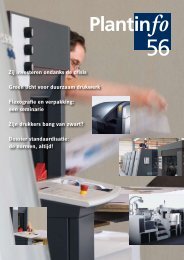A hArd-hitting - Plantin
A hArd-hitting - Plantin
A hArd-hitting - Plantin
Create successful ePaper yourself
Turn your PDF publications into a flip-book with our unique Google optimized e-Paper software.
Perfect Plate Production –<br />
Seeing the light!<br />
the right chemicals are not enough: the only way of achieving optimum print<br />
results is if the actual medium transferring the text and image data – the printing<br />
plate – is perfect, too. although thermal imaging and subsequent processing of the<br />
plate is fairly straightforward, it does require a certain degree of specialist know-how.<br />
to all intents and purposes, even state-of-theart<br />
CtP platesetters contain a mini photo lab.<br />
although they avoid having to go through the<br />
laborious process of developing negatives (film),<br />
the images (plates) still need to be imaged correctly<br />
– and that means, for example, that the<br />
imaging time and energy need to be right. it is<br />
also important to perform regular checks on the<br />
developing chemicals and other process parameters<br />
used. if something goes wrong here, this<br />
may result in banding in the print. this takes the<br />
form of fine lines or stripes approximately 0.04<br />
to 0.1 inches (1 to 2.5 mm) apart that spoil the<br />
print image (ill. 1).<br />
Before wasting valuable hours looking for the<br />
cause of the problem on the press, it is therefore<br />
worth taking a look at prepress, including the<br />
platesetter settings. although cutting-edge CtP<br />
devices such as the suprasetter from Heidelberg<br />
monitor and adjust the laser power on an ongoing<br />
basis, incorrect settings almost inevitably<br />
lead to unwanted effects. irrespective of the<br />
make of the platesetter, it is also a good idea to<br />
regularly check the loading and unloading<br />
mechanisms for signs of wear. and what about<br />
the plates? they should be stored correctly so<br />
that their sensitivity and thus their imaging<br />
performance are not impaired (ill. 2).<br />
it goes without saying that chemicals also<br />
play a key role in the processor. for example,<br />
consumption and evaporation must be balanced<br />
correctly – and constantly – to ensure<br />
that the developer does not show any “signs of<br />
fatigue.” this only works, however, if an eye is<br />
also kept on consumption/oxidation on a dayto-day<br />
basis so that the developing fluid can be<br />
refilled as required. otherwise, it gradually becomes<br />
less effective. a backflow of water from<br />
the squeegees can have a similar effect, in<br />
some cases. in order to prevent dilution of the<br />
developing fluid, the setting of the squeegees<br />
and the position of the spray tube should also<br />
be checked. the condition of the developer can<br />
be assessed using either a pH measurement (in<br />
the case of developers for photopolymer plates)<br />
or a conductivity measurement (suitable for<br />
many thermal plates).<br />
if the chemicals are right but the print is still<br />
somewhat cloudy, it may be worth taking a<br />
closer look at plate transport. if a wave of developer<br />
runs back as the plate is passing through<br />
the machine, this could indicate that the chain<br />
tension or the rollers on the drive need to be<br />
readjusted. last but not least – and as in any<br />
conventional photo lab – there is also a possibility<br />
of the developing fluid simply being too<br />
hot or too cold. for safety purposes, a digital<br />
or alcohol thermometer is used to establish<br />
whether the heating or cooling system is faulty<br />
because there is a risk of conventional mercury<br />
thermometers breaking and ruining the<br />
entire machine. the ideal temperature of the<br />
developing fluid is indicated by the relevant<br />
plate suppliers.<br />
to keep printing operations running smoothly,<br />
it is thus advisable to ensure that plate production<br />
is always up to scratch. the test forms<br />
included as standard with all Heidelberg platesetters<br />
can make a significant contribution in<br />
this respect. they make the operator’s daily<br />
checks much easier, especially given that they<br />
also enable conclusions to be drawn about the<br />
actual developing process. in other words, the<br />
operator always has effective help at hand to<br />
ensure the process is stable. Plates and processing<br />
chemicals in the saphira range from<br />
Heidelberg go a long way towards ensuring<br />
that the prepress “photo lab” operates smoothly<br />
– as do the customized systemservice maintenance<br />
programs that can be agreed with<br />
Heidelberg. in order to keep downtimes to an<br />
absolute minimum, an appropriately equipped<br />
TIPS<br />
anD<br />
TRICKS<br />
Service<br />
Ill. 1: Possible causes of the phenomenon known as<br />
banding include incorrect setting of the platesetter system<br />
and wear on the loading/unloading mechanisms.<br />
Ill. 2: Uneven results and cloudiness are often caused<br />
by faulty plate transport.<br />
suprasetter can even provide Heidelberg service<br />
specialists with details on the machine’s<br />
status or inform them if a wear part will soon<br />
need to be replaced. this is done over the internet<br />
in a matter of seconds. if the modern-day<br />
“photo lab assistant” gives the go-ahead for the<br />
data to be sent, it saves time, money, and hassle<br />
– to the benefit of everyone involved! n<br />
Info<br />
Products described here may not be available in<br />
all markets. You can get further information from<br />
your local Heidelberg representative.<br />
53





